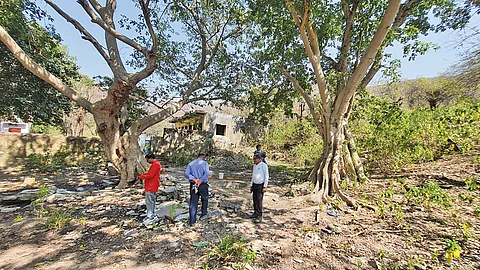

In Rajasthan's Alwar district, the revival of the sacred grove Chudasidh Adavad has transformed a barren land into a thriving ecosystem, supporting 2,000 animals.
Community efforts, aided by KRAPAVIS, have restored native flora and created water resources.
This model is inspiring similar initiatives, though experts stress the need for policy support to protect all 25,000 orans in the state.
“This is a baura (deity) who only gives and never takes,” says 55-year-old Pappu Girdhari, describing Chudasidh Adavad devbani. Situated 2 km from his village Sirawas in Rajasthan’s Alwar district, the 150-hectare (ha) sacred grove, or oran, serves as a pasture for his 40 buffaloes and 90 goats. “For the past 15 years, I have grazed my animals here every day, except in May and June,” he says.
Ramfal, another cattle-breeder, has been grazing his 50-55 goats in the oran for the past seven years. With sufficient fodder available, he does not have to migrate in the summer months with his goats. Overall, 2,000 animals in Sirawas rely on Chudasidh Adavad—one of Alwar’s 12 orans named after the deity Chudasidh.
The practice of developing orans, which are community forests named after deities, nature or ancestral spirits, is prevalent across the country. While in Rajasthan they are called devbani, in Maharashtra they are devrai, in Madhya Pradesh and Jharkhand sarna, and in Kerala kavu.
But across states, orans have ended up in a degraded state due to lack of proper upkeep, encroachment or excessive development in the name of land reform. “Orans were fine before the 1950s and protected by communities. But with progressive policies and so-called land reform, these forests were put in the revenue category,” Aman Singh, chief coordinator of non-profit Krishi Avam Paristhitiki Vikas Sansthan (KRAPAVIS) that works on protection of sacred groves in Rajasthan, tells Down To Earth (DTE). Oran land was marked for development activities like agriculture and mining. “The destruction of many orans for the Delhi-Mumbai Expressway is a recent example of this,” says Singh.
Chudasidh Adavad near Sirawas was hit by such destruction. Girdhari says that till 2010, the area was barren. People were forced to migrate for animals to graze.
But in 2009-10, the idea of its revival was floated after KRAPAVIS began a study of orans in Alwar. In the first phase of the study, a survey was conducted in the villages. Residents revealed that Chudasidh Adavad used to have two drains that would help in irrigation of crops, especially in rabi season. But they gradually degraded. The land was also overrun by Prosipis julifora, an invasive weed, and native grasses and plants vanished.
KRAPAVIS then worked with the residents to identify the measures to be taken to revive the oran. In 2011, the community began by creating eight to 10 loose-boulder check dams to arrest soil erosion and retain rainwater. They also laid native grass on about 4 ha.
In 2012-13, the village residents formed a committee to coordinate the revival work. Over the next few years, they created a pond, planted native grasses and trees. In 2017, the committee took over the oran’s management. Overall, the work cost Rs 60 lakh, of which the community gave 25 per cent and the rest was facilitated by the non-profit.
Now, the forest has 3,420 plants, including fruiting trees like date palm, fig, Indian gooseberry, lemon and pomegranate. Apart from fruits, the community is able to collect resources like date palm leaves to make brooms. Farmers use the water in the ponds and check dams for irrigation—some have installed pipes to transport the water up to 1 km. Animals and birds, like peacocks, hill birds and Indian robins, populate the oran.
However, the area now has a water problem, says Girdhari.
Water leaks from roots of fig trees and, due to lack of a proper storage system, flows into the Siliserh lake 15 km away. Residents are building another check dam to resolve this.
Sirawas’ model of oran revival is being replicated in other villages of Alwar. For instance, Kalikhol village, 25 km from Sirawas, also has an oran named after the deity Chudasidh. Kalikhol is in the Bhagapura panchayat, on the border of the Sariska Tiger Reserve. The area around the village is partly oran land and partly revenue land. Residents began a revival process in 2014, with help from KRAPAVIS, in a similar phased manner as Sirawas. But in Kalikhol, coordination and management was taken up by a women’s committee. Chammo Devi, president of the committee tells DTE that recently, 20 women of the village spent a month building a new pond that will be useful for animals and for irrigation.
Alwar has good examples of how community-led initiatives are reviving orans. But Singh questions their scalability. “There are about 25,000 orans in Rajasthan, covering 0.6 million ha. It will take centuries to protect all of them by an organisation like KRAPAVIS,” he says. This work is possible only with changes at policy level.
Singh highlights how in 2010, when Rajasthan’s first forest policy was made, the forest department had no information about orans. Inter-ventions by non-profits like KRAPAVIS resulted in a separate section in the policy. It was eventually removed in the new state forest policy in 2020.
In December 2024, the Supreme Court, hearing a petition from Singh, directed the Rajasthan forest department to identify and notify sacred groves with on-ground and satellite mapping. The court recommended that the Union Ministry of Environment, Forest and Climate Change create a comprehensive policy for governance and management of sacred groves.
In the months since the ruling, an expert committee has been set up and is planning implementation of the order with the state government, Singh says. “I hope this gets orans more attention not just from communities and non-profits, but also from policymakers,” he says.
(This story has been published under the Promise of Commons Media Fellowship 2024)
This article was originally published in the June 1-15, 2025 print edition of Down To Earth